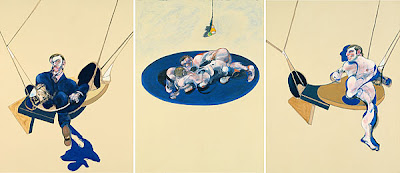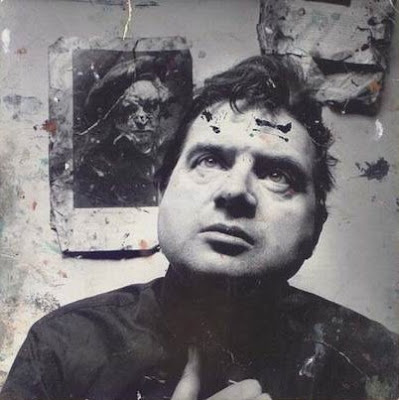Francis Bacon is one of the great painters of the 20th century. His works exude a sensual enjoyment of paint and embody the extremes of human experience. Fascinated with the human body and flesh, Bacon was committed to painting the figure in an innovative way and stood apart from many of the movements, such as abstraction, then dominating the art world.
Bacon’s often confronting imagery, gleaned from diverse sources, has retained its intensity and has had a lasting impact on 21st century artists.
Bacon was born to Protestant parents in Dublin in 1909. At the age of 16, after being evicted from home by his father, he travelled to London, subsequently spending time in Berlin in 1927 during the rise of the Nazis. He then went on to Paris, where his encounter with the work of Pablo Picasso became a catalyst for him to paint. After returning to London in 1929 he briefly worked as an interior designer before turning to painting. Bacon was entirely self-taught as a painter. In the early 1930s he participated in several group exhibitions in London, but in the later 1930s and early 1940s he suffered a crisis of confidence and destroyed much of his work. In 1944, after wartime service in the Civil Defence, he resumed painting, and was at first much influenced by the work of Picasso, and then, in the early 1950s, by the Surrealists. His
Three Studies for Figures at the Base of a Crucifixion (1944), now in the Tate, caused a sensation when the Lefevre Gallery exhibited it in 1945. He drew on various sources for inspiration, in particular Velazquez’s
Portrait of Pope Innocent X, and also photographs and film stills, as well as producing numerous portrayals of friends and lovers.
Bacon’s first retrospective was at the Institute of Contemporary Arts in London in 1955, and important exhibitions of his work have been held regularly ever since: at the Guggenheim Museum in New York in 1963; the Grand Palais in Paris in 1971; the Metropolitan Museum of Art, New York, 1975; in Washington, Los Angeles and New York in 1989-90, and at the Musée National d’Art Moderne in Paris in 1996.
Bacon lived and worked for most of his adult life in London and died in Madrid in 1992.
1940s. Bacon’s bold vision emerged in the final years of World War II in a Britain shattered by profound violence and destruction. Only a few of his paintings from the 1930s and early 1940s survive, the artist having destroyed many of his works during this period.
Bacon was excused from active military service due to asthma, but he worked for a time in Civil Defence. This too was curtailed because of the dust caused by the constant bombing and demolition in London. With his lover, the collector and businessman Eric Hall, he moved to a cottage in Hampshire.
Much of Bacon’s work from the 1940s relates to his crucifixion series. The scream – drawn from a range of sources including the screaming nurse in Sergei Eisenstein’s 1925 film
Battleship Potemkin – recurs in many of his paintings. Bacon’s screaming figures crouch beneath umbrellas or are enclosed in cage-like structures.
A series of paintings of heads from this period blur the boundaries between human and animal. And at the close of the decade Bacon began painting the male nude, a move towards the eroticism and surprising tenderness that characterised some of his later works.
 |
| Untitled (Study for a Figure at the Base of a Crucifixion), c. 1943–44 (Oil and pastel on board, 94 × 74 cm., Courtesy Murderme). This study is a variation on the right panel of Bacon’s breakthrough triptych Three studies for figures at the base of a crucifixion 1944, painted after several years during which Bacon destroyed or painted over nearly all of his work. The monstrous figure in this image has been linked to the vengeful Eumenides of ancient Greek mythology. Informed by both Aeschylus’s bloody play Oresteia and TS Eliot’s 1939 reworking of it in The family reunion, these frightening creatures appear in many of Bacon’s works. |
1950s. Despite an unsettled lifestyle and not having a permanent studio, the 1950s was a productive period for Bacon. In 1956, Peter Lacy – his lover during these years – moved to Tangier, Morocco, where Bacon visited him.
In this decade Bacon experimented with subject matter and technique, and expanded his sources for imagery – ranging from personal experience to the work of artists such as Velázquez and van Gogh, film stills, pages torn from books and magazines and the analytical photographic motion studies of Eadweard Muybridge. In fact Muybridge’s 19th-century photographs informed several of Bacon’s paintings, including those of wrestling men, although Bacon’s figures have distinctly sexual overtones.
Many of Bacon’s works from this time were painted in series and often hastily completed for exhibition deadlines. He applied paint more thinly than in earlier work, with the colour and texture of raw canvas visible beneath translucent washes. Reflecting the muted colours and claustrophobic atmosphere of 1950s London, Bacon’s palette was dominated by subdued greys, blues and earthy tones. There were some exceptions such as the van Gogh series.
 |
| Figure with meat, 1954 (Art Institute of Chicago). This painting is closely related to Bacon’s popes. The figure of the Pope represents Bacon’s tendency to portray authoritative, dominating men throughout the 1950s. In dry brush marks of red, orange, cream and blue, it is a painterly depiction of flesh that shows Bacon’s fascination with meat and his belief in the parity of human and animal flesh. As he once remarked to David Sylvester: "we are meat, we are potential carcasses. If I go into a butcher’s shop I always think it’s surprising that I wasn’t there instead of the animal." |
1960s. Bacon moved into a studio in Reece Mews, South Kensington in 1961 and he lived and worked there until the end of his life. The studio was also home to his vast and chaotic accumulation of source material for his paintings, now preserved in its entirety in Dublin City Gallery The Hugh Lane.
In 1963 Bacon met George Dyer, his lover for the rest of the decade. He began making portraits of Dyer and his friends from the Soho scene: Isabel Rawsthorne, Muriel Belcher, Henrietta Moraes and the artist Lucian Freud. Many of these portraits were based on photographs Bacon commissioned from John Deakin.
In this period – and perhaps in line with the lively atmosphere of London in the sixties – Bacon’s compositions became more daring. He began to use areas of flat, high-key colour to frame and isolate his figures, and painted portraits on a smaller scale. These portraits are among his most adventurous works, conveying a distinct likeness with thick twists of paint which seem to consist of only a few wild strokes and turns of the brush.
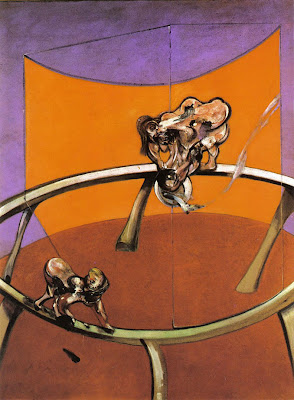 |
| From Muybridge--The Human Figure in Motion: Woman emptying a Bowl of Water and Paralytic Child on All Fours, 1965 (Oil on canvas, 198 × 147.5 cm, Stedelijk Museum Amsterdam). This painting, which brings together a woman with a bowl of water and a paralytic child on all fours, acknowledges the groundbreaking photographs of Eadweard Muybridge in its title. When Bacon considered turning his hand to sculpture, this was one of the works that he thought could form the basis for a three-dimensional object. He proposed constructing the railing in the image and setting both of the figures on tracks so that they could be moved along it. The image reflects the motion that Muybridge studied in his photographs. Here the woman’s body seems to capture not one moment in the movement but the entire gesture. |
1970s. This decade had a momentous beginning for Bacon. In 1971 a major book on his work by the art critic John Russell was published. In the same year, he was given a retrospective exhibition at the Grand Palais in Paris which marked his critical and commercial success. Tragically, on the eve of the exhibition opening George Dyer, Bacon’s long-term lover, was found dead in his hotel room – an event that would haunt Bacon.
Bacon produced some of his most poignant and powerful triptychs in this period. Breaking his own precedent of never painting the dead and his rule of not representing a narrative, several triptychs memorialise Dyer and aspects of their life.
In the mid 1970s Bacon met John Edwards. He became his close companion and, like Dyer, featured in many portraits and figure studies. The relationship with Edwards lasted until the artist’s death and he was the sole inheritor of Bacon’s estate.
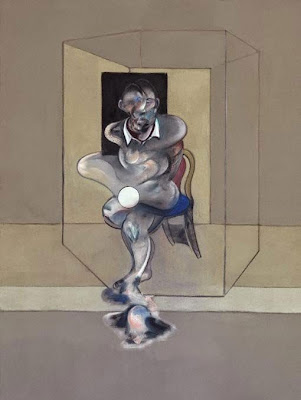 |
| Study for Self-Portrait, 1976 (Oil and pastel on canvas, 198 × 147.5 cm; Art Gallery of New South Wales, Sydney, Australia). In this self-portrait Bacon depicts his body in tumult. Seated on a stool, he seems to twist around himself in a corkscrew motion that indicates awkwardness and anxiety. In many filmed interviews, Bacon’s unease is apparent in postures such as this. The musculature of his figure is picked out with dashes of white and cream paint on his shoulder, knee and calf. Tilted towards the viewer, his head and shoulders are framed by a rectangular black void. Against a cool background, his body casts a shadow that has a material presence – like an object or an extension of Bacon’s own flesh. The white disc at the centre of the composition may be seen as a contrast to the twisting paint that typically describes the body. |
1980s. Bacon’s work in the 1980s varies stylistically from that of previous decades. His technique was confident and the sense of chaos and drama of his earlier paintings was replaced with more sober control. In these works the paint is flat yet vibrantly coloured; the shadows, which feature in many of his earlier works, are solid and fleshy.
By 1980 most of Bacon’s close companions had died. Apart from the artist Lucian Freud and the art historian David Sylvester, who outlived him, Bacon was the last of a fascinating circle of Soho-scene figures. Towards the end of his life he was sustained by his stable relationship with John Edwards, although a liaison with Spaniard José Capello took Bacon to Madrid, where he died in 1992.
Bacon painted until the end of his life and left behind a unique and powerful body of work. As Alan Bowness, former director of the Tate in London, said: "for Bacon the virtues of truth and honesty transcend the tasteful. They give to his paintings a terrible beauty that has placed them among the most memorable images in the history of art."
 |
| Figure in Movement, 1985 (Oil on canvas, 198 × 147.5 cm; private collection). One of several paintings portraying men wearing cricket pads. The figure here is isolated between planes of iridescent orange on an elevated field or tabletop. When asked about his references to cricket Bacon resisted pinning it down, commenting only that he was aware of the game’s importance to the British. His interest in sports of all kinds is more indicative of his attraction to the virile male form in movement. |
QUOTATIONS
I would like my pictures to look as if a human being had passed between them, like a snail, leaving a trail of the human presence and memory trace of past events, as the snail leaves its slime.
I’m just trying to make images as accurately off my nervous system as I can.
The artist may be able to open up or rather, should I say, unlock the valves of feeling and therefore return the onlooker to life more violently.
In trying to do a portrait, my ideal would really be just to pick up a handful of paint and throw it at the canvas and hope that the portrait was there.
The sitter is someone of flesh and blood and what has to be caught is their emanation.
I always think of myself not so much as a painter but as a medium for accident and chance.
We are born and we die, but in between we give this purposeless existence a meaning.
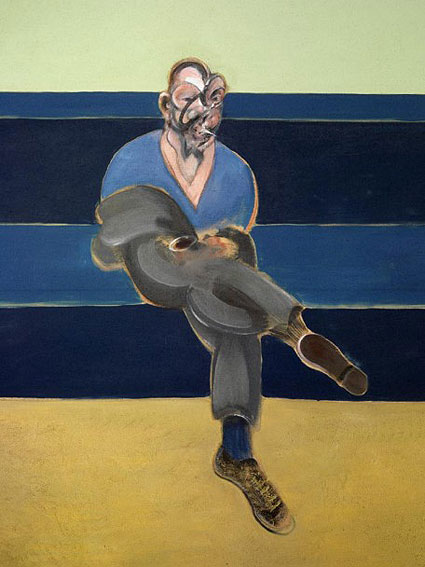 |
| Study for Portrait of P.L., 1962, oil on canvas, 198 x 145cm., Hazlitt Holland-Hibbert, London. Painted 1962 in memory of Peter Lacey. |
SUBJECTS AND INFLUENCES
Source material from Francis Bacon’s studio. After Bacon’s death, the 7 Reece Mews studio in London remained largely untouched until 1998 when his sole heir, John Edwards, presented it to Dublin City Gallery The Hugh Lane where it was faithfully reconstructed and opened to the public in 2001.
An inveterate hoarder of pictorial material, Bacon eventually accumulated more than 7500 items in his studio, including books, magazines, newspapers, photographs, drawings, handwritten notes, destroyed canvases and artists’ materials. Of this cluttered mess he said: ‘I feel at home here in this chaos because chaos suggests images.’ In this disorder, he may have seen accidental juxtapositions – photographs of himself, his friends and lovers became mixed in with images from mass media, and of animals, old master paintings and film stills. Other items are pages torn from
Phenomena of Materialisation, a book that purported to show ghostly, ectoplasmic forms; sensual nudes held together with paperclips; and images featuring motifs he used in his work such as the crouching nude
Friends and lovers. Bacon painted many portraits of his close friends and lovers. From the 1960s onwards these were typically based on photographs he commissioned from John Deakin. Bacon often directed these photographs in order to obtain the poses that would best suit the paintings he had in mind. Among them are images of Reinhard Hassert and Eddy Batache, John Edwards, Bacon’s close companion from the 1970s until his death, and French intellectual Michel Leiris as well as Isabel Rawsthorne, a set designer with art-world connections, artist Lucian Freud and bon vivant and beauty Henrietta Moraes.
Although he used photographs as sources for paintings, Bacon downplayed their significance, saying "It’s easier for me to work from these records than from the people themselves; that way I can work alone and feel much freer… These photographs were my aide-memoire, they helped me convey certain features, certain details."
Artist as subject. While Bacon once claimed that he "loathed" his own face, he kept many images of himself in his studio. Some were taken by friends or professional photographers in his colourful and chaotic studio while others were casual self-portraits taken in photo booths. According to Bacon, he used photographs as a reference for self-portraits but he also looked in the mirror.
Mass media and popular culture. Many items found in Bacon's studio were drawn largely from magazines, newspapers and books. They range from a photograph of hands gripping a golf club, to a bullfight and a still from Alain Resnais’ 1959 film
Hiroshima mon amour. Pinned to a piece of card, this image informed some of Bacon’s paintings of Henrietta Moraes. The diverse mix of popular and fine art references in his studio demonstrates what Bacon himself once said: "I’m influenced by anything. I can be influenced by a news photograph or some photo I find in a magazine as much as I can be influenced by a Velázquez."
. Bacon was influenced by particular artists and images from art history such as Velázquez’s 17th-century painting of pope Innocent X. Bacon said of this painting: "I’ve always thought this was one of the greatest paintings in the world and I’ve had a crush on it." Bacon also collected sensual drawings of bodies by Italian Renaissance artist Michelangelo, which he said taught him about the voluptuousness of the male form.
